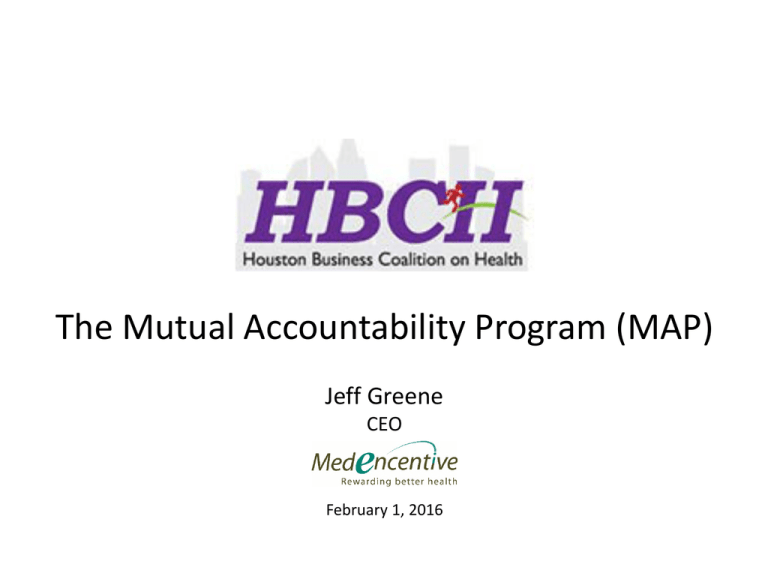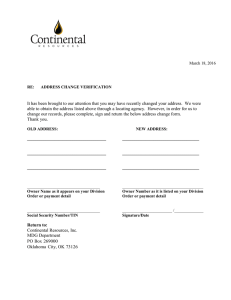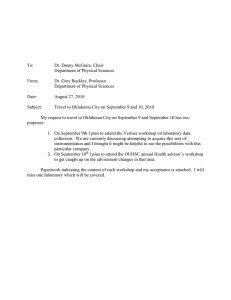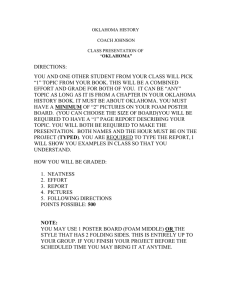
The Mutual Accountability Program (MAP)
Jeff Greene
CEO
February 1, 2016
The State of Oklahoma Mutual
Accountability Program Pilot
Crisis One
Our country needs to be healthier...
3
Crisis Two
Our country needs better value from its
healthcare delivery system...
4
Crisis Three
Our country must contain healthcare
expenditures...
5
Solving These 3 Crises Now Has a Name
The “Three-Part
or Triple Aim”
Most precisely defined as simultaneously:
1. improving health and;
2. improving health care;
3. in a manner that leads to lower overall costs and a
return on investment in a normally distributed
population
Heretofore, the Three-Part Aim has
never been achieve...
6
The Obvious Solution to These Challenges
Motivate Better Human Behavior
By combining human factors and systems
engineering with web-technology and an
array of social sciences…
…MedEncentive has developed a patented
incentive system that has been independently
validated to improve human behavior in a
manner that solves the “three-part aim.”
How the Mutual Accountability
Program Works
The Key to Health Care Cost Containment
No health care cost containment solution can be
sustained without balancing the interests of the
essential stakeholders; like a three-legged stool
Consumers/
Patients
Physicians
Employers/Insurers
(plan sponsor/risk-bearing entity)
Alignment-of-interests to create a win-win-win proposition
© 2016 MedEncentive, LLC. All Rights Reserved
The employer and insurer sponsored
patient accountability movement
Consumers/
Patients
No Physician
Accountability
Physicians
Patient Accountability
• Wellness and prevention
• High-deductible consumer$
driven health care
• Disease/care management
Employers/Insurers
(plan sponsor/risk-bearing entity)
Requires large financial incentives, which impedes ROI
© 2016 MedEncentive, LLC. All Rights Reserved
The government and insurer sponsored
provider accountability movement
Consumers/
Professor
Christensen says:
No Patient Accountability
Patients
Physicians
Provider Accountability
“In other words, ACOs hold caregivers accountable
without
• Capitated HMO
requiring patient accountability. How can this work?”
• P4P $
• Accountable Care Org.
• Episodic care payments
Employers/Insurers• Medical home
(plan sponsor/risk-bearing entity)
Limited to no proof that this approach produces an ROI
© 2016 MedEncentive, LLC. All Rights Reserved
The MedEncentive approach is
fundamentally different
“Triangulation” to achieve the “Three-part Aim”
Consumers/
Patients
$
Physicians
Intermediary
$
Employers/Insurers
(plan sponsor/risk-bearing entity)
This model has proven time and again to produce large ROI
© 2016 MedEncentive, LLC. All Rights Reserved
How the Mutual Accountability Program Works
Plan sponsors (health insurers, employers and governments)
underwrite the Program’s costs, arrange to have eligibility and
claims transmitted to MedEncentive, pay rewards transmitted by
MedEncentive, and then pocket the savings
Doctors and patients earn financial rewards immediately after
each office visit by voluntarily accessing MedEncentive’s website
to complete an information therapy (Ix®) session
© 2016 MedEncentive, LLC. All Rights Reserved
13
How the Mutual Accountability Program (MAP)
Works
Physicians are compensated with each office visit involving a MAP
beneficiary for accessing the MAP website to:
1. Enter the patient’s name and diagnosis or respond to an email notice from
MedEncentive;
2. Declare adherence or provide reason for non-adherence to an evidencebased treatment guideline related to the patient’s diagnosis;
3. Prescribe educational material from a list of articles relevant to the patient’s
diagnosis as “homework” (information therapy - Ix®)
4. Agree to allow the patient to confirm the physician’s adherence to the
guideline and educational material or concur with the physician’s reason for
non-adherence;
5. Agree to monitor the patient’s education and declaration of adherence
through the Program.
Takes less than a minute, making participation in the Program one of the
most lucrative services rendered in clinic.
© 2016 MedEncentive, LLC. All Rights Reserved
The Information Therapy (Ix) Program Basics
▪
First step – Tell the patient whether or not an evidence-based guideline fits
Anti-cookbook medicine feature
© 2016 MedEncentive, LLC. All Rights Reserved
The Information Therapy (Ix) Program Basics
▪
Second step – Prescribe information therapy to the patient as “homework”
Educational articles listed in
relevancy to patient’s diagnosis
© 2016 MedEncentive, LLC. All Rights Reserved
How the Mutual Accountability Program (MAP)
Works
Patients earn back some or all of their office visit co-payment (typically $15 to
$25) by accessing the MAP website, in response to an information therapy
prescription letter sent to their home after each office visit, to:
1. Read the prescribed educational article relevant to their diagnosis;
2. Demonstrate their understanding of the article by passing an open-book
test and/or declaring their comprehension;
3. Declare their adherence or provide a reason for non-adherence to the
article’s recommendations;
4. Agree to allow their physician to review their comprehension and
declaration of adherence or reason for non-adherence;
5. Rate their physician’s performance against what they’ve read and the
physician’s declaration of adherence or reason for non-adherence to the
recommended treatments.
© 2016 MedEncentive, LLC. All Rights Reserved
Why the Mutual Accountability
Program Works
Understanding how motivators function is essential...
• Financial incentives are like a sugar high - very powerful, but they
don’t last very long
• Interpersonal relationships (what others think about us) are
powerful and long lasting motivation
• Knowledge is empowering, motivational and can last a lifetime
Harnessing the power of these three motivators in a
systematic manner is the key to improving human behaviors
and controlling cost
© 2016 MedEncentive, LLC. All Rights Reserved
Mutual Accountability Program’s Scientific Basis
Health literacy is the single strongest
determinant of life expectancy and how much
health care a person will consume in a lifetime.
Poor doctor-patient communications…
A battery of studies have determined:
• Doctors interrupt patients within the first 23 seconds
• 15% of patients fully understand their doctor
• 50% of patients comply with doctors’ orders
• Causes misdiagnosis, inferior clinical outcomes,
malpractice, and higher costs
What you don’t know can kill you…
and can also bankrupt you
Northwestern and Emory
researchers found that health
literacy is directly correlated to life
expectancy
Multiple studies compiled by the
U.S. government found that health
literacy is directly correlated to
healthcare costs
When people know the “how” and “why,” they are more empowered and motivated to comply with recommended treatments and adopt healthy behaviors. Behavioral science
calls this the:
Knowledge-Adherence Response
This helps explain why the MedEncentive Program’s
“information therapy” feature is so important.
22
Mutual Accountability Program’s Scientific Basis
The Hawthorne effect is a psychological
phenomenon that produces an improvement in human
behavior or performance as a result of increased attention
from superiors or persons in positions of authority and trust.
In all cases, observed individuals behave or perform better
than unsupervised individuals for a limited time if they
suspect or know about the observation.
23
Overwhelming evidence indicates that the motivators present
in the doctor-patient relationship influence behaviors...
Doctor-Patient Relationship Influences Patient Engagement
Release Date: November 29, 2011 | By Valerie DeBenedette, Contributing Writer
Research Source: Center for Advancing Health
Behavioral science refers to this phenomenon as the...
Researchers asked 8,140 people in the U.S. with chronic illnesses
about
their experiences with their physicians,
as well as
about their
Authority-Adherence
(Obedience)
Response
socioeconomic status, overall health and how they make use of health
services. is analogous to the Hawthorne Effect
...which
Patients who perceived their physicians were involved in their
carehelps
were explain
more likely
monitor
their bloodProgram’s
pressure, exercise
This
whytothe
MedEncentive
“mutual
five days a week
and adhere
to medication regimens, among
accountability”
feature
is so important.
other healthy behaviors.
Harnessing the power of three motivators in a systematic manner
is the key to improving human behaviors and controlling cost
Program is effective because it:
1. Uses “precision-guided financial rewards” to...
2. Invoke the Hawthorne Effect and customer psychology by tapping
into the doctor-patient relationship to cause a state of “mutual
accountability”
3. Advance patient health literacy with what is called “information
therapy”
© 2016 MedEncentive, LLC. All Rights Reserved
25
The Mutual Accountability Program works because...
1. Patients don’t want their doctors to think they are health illiterate
and non-compliant
2. Doctors don’t want their patients to think they practice
substandard care
3. Health literacy and the Hawthorne Effect causes an
improvement in medication adherence and other types of
patient compliance
4. Service and image psychology causes healthcare providers to
improve their performance
5. Hospitalizations decline
6. Patient accountability relieves some degree of defensive
medicine
7. Cost are contained to the point a return on investment is
realized
Measuring How Well the
Program Works
Trial results and independent analyses
Five year report examined the results of 7 trial installations...
© 2016 MedEncentive, LLC. All Rights Reserved
After reviewing MedEncentive’s Five Year Report, researchers at the University of
Kansas School of Medicine (KUSM) summarized the findings in this poster, which
was presented in October 2009 at the National Institutes of Health Conference on
Health Literacy in Washington, DC. This earned KUSM a grant to study the results of
two of MedEncentive’s trial installations, which are reported on the subsequent slides.
MedEncentive’s Estimated Impacts on
Employer’s Costs of Insurance and
Individual Healthcare Costs:
a Preliminary Case Study
• Douglas D Bradham, Dr.P.H., Kansas Health Foundation
Distinguished Professor of Public Health – Health Economist
• Nikki Keene, MA, MPH, PhD Candidate – Behavioral Psychologist
• Traci Hart, PhD , Research Assistant Professor – Human Factors Psychologist
• Phillip Twumasi-Ankrah, PhD, Assistant Professor - Biostatistician
• Amy Chesser, PhD, Research Assistant Professor – Healthcare Communications
Department of Preventive Medicine and Public Health
University of Kansas, School of Medicine – Wichita
The Kansas Trial
The
Trial
In the 2½ years
afterOklahoma
the Wichita Clinic
implemented the
Over
a four yearProgram:
period after implementation, the City of
MedEncentive
Duncan employee health plan realized a savings of
• Office visits increased 13%
between $3.1 and $17.7 for each $1 invested in the
• MedicationProgram.
adherence reported at 94%
MedEncentive
• Hospitalizations decreased 55%
(Validated non-catastrophic and total claims expenditure against average trend over 4 years)
Refer to University of Kansas School of Medicine research abstract and poster (following slide)
• Located in Pasco, Washington
• Founded in 1916
• Faith-based hospital system
The Loomis Company Analysis of MedEncentive at
• 1,100 health
plan members award winning insurance
Wyomissing,
Pennsylvania-based
Lourdes
Health Network
services
company
• Unionized
workforce
Founded
in 1955,
family-owned
and to
operated
• Escalating
healthcare
costs prior
adopting the
Tom Forsbeg, The Loomis Company
MedEncentive
Program
in 2008
Offices located across
the country
• Anparty
Ascension
Health facility
Third
administrator
for Lourdes Health Network
The Washington Trial
•
•
•
•
Over $3M
savingsvs.inHow
lastcan
three
Three
yearQuestion:
savings
MedEncentive
program
Causality
theyears
ROI
be
investment
12:1 ROI
attributed
to=MedEncentive?
Answer: As participation
in Health
MedEncentive
went up, health
Lourdes
Network
Return on Investment
in the MedEncentive
Program
literacy and medication
adherence
increased,
while
hospitalizations
declined, which produced the savings...
$3,500,000
$3,000,000
$2,500,000
$2,000,000
$1,500,000
$1,000,000
$500,000
$0
“After analyzing the results from MedEncentive’s trials, we are impressed with the firm’s
approach to mitigating healthcare costs by promoting health.
Because of our confidence in the MedEncentive Program, we will provide a discount on
Sun Life Stop-Loss premium to customers who participate in the program.”
Scott Beliveau, Sun Life Financial Stop-Loss Vice President
No stop-loss carrier has ever publically endorsed a health
improvement program. Now three of the top-ten have...
...Sun Life, AIG and IHC Risk Solutions.
What Others Say
“After analyzing the results from MedEncentive’s trials, we are impressed with the firm’s approach to mitigating healthcare costs by
promoting health. Because of our confidence in the MedEncentive Program, we will provide a discount on Sun Life Stop-Loss premium to
customers who participate in the program.”
Scott Beliveau, Sun Life Financial Stop-Loss Vice President
“While we’ve saved millions of dollars over the years with our wellness program and MedEncentive, the most important attributes
about MedEncentive are how much our employees appreciate the program, how simple it is to maintain and how very little
administrative support is required. It has been a win for our organization, our employees and our physicians.”
Shannon Douglas, Compensation/Benefits Manager | Human Resources Lourdes Health Network
“We are very pleased with how easy the
MedEncentive Program was to
implement and how very little time is
needed in support of this program.
Our employees like the program and
participation has reached over 65%
within 6 months with very little effort
on our part.”
Erica Pridy, Benefits Director Heyco
Products, Inc. Toms River, New Jersey
“This is great! I like the information and getting paid to take better care of myself is the BEST idea
ever!”- Elayne (Patient)
“This program is easy to use! I have found the information relevant to my health care needs. The
articles are easy to read and the questionnaire is quick to fill out. I appreciate this opportunity to
earn some cash!”- Rhett (Patient)
“This is a wonderful program. One of very few targeted to personalize my healthcare &
physician relationship. I will continue to take advantage of this program as long as it is
offered.”- Rita (Patient)
“...I see it (MedEncentive) as a tool that’s been a blessing for me and my patients.”
Jenny Vickrey, M.D., Washington state obstetrician-gynecologist and MedEncentive practitioner
“MedEncentive is easy and quick to use... I think it serves as a good second opinion for me and provides valuable information to my patients.
And to top it off, the program increases my reimbursement and my patients are very motivated to get their co-pays back.“
35
Todd Clapp, M.D., Oklahoma Internal Medicine and Pediatrics, INTEGRIS Health
The State of Oklahoma Mutual
Accountability Program Pilot
The Mutual Accountability Program (“MAP”) Pilot Project
A three-year pilot involving a cohort study using an appropriate scientific
•methods
After
reviewing
the
MedEncentive
Program
and
the independent
The bill
that launched
the
pilot costs
(HB1062)
passed
by the
to principally
compare
per-capita
of an intervention
group
covered
that
validated
the
program’s
cost
savings
capabilities,
by studies
the
MAP,
comprised
at 46-0
least
15,000
HealthChoice
beneficiaries
of schools
Oklahoma
Senate
and
the
House
86-9.
Broad
are
involved
in ofthe
largest
health
improvement/
districts,
Statefrom
agencies
and local governments
concentrated
in seven
Oklahoma
State
legislative
leadership
approached
MedEncentive
support
Democrats
and
Republicans
and
fromcounties,
cost
containment
(Three-Part
Aim)
experiment
against
a control
group consisting
of the
remaining
HealthChoice
enroll-ment
of
about
conducting
a
pilot
with
State
agencies
and
public
school
organized
labor,public
business
the medical
ever attempted
in
the
U.S.and
approximately
110,000
sector
employees
and their communities
families.
The State of Oklahoma and MedEncentive
districts.
due to the MAP’s independent validation and
MedEncentive’s willingness to subject the MAP to a public
• The
trial.fact that MedEncentive is one of the few vendors willing to
MUTUAL ACCOUNTABILITY
PROGRAM PILOT
put is program to the test in a publicly scrutinized, matched-cohort
study spoke volumes to the legislators and the governor.
• In a time of severe polarization of the subject of health
reform, no other health reform measure has been passed
by an elected body in the U.S., unanimously.
State of Oklahoma Pilot
Patient Activity
Metrics that predict success
Based on our 10 years of experience, the strongest determinant of a
return on investment is the Patient Success Rate
Patient Success Rate = the total number of information therapy
sessions ÷ the total number of office visits incurred by the covered
population
In our previous trials, a Patient Success Rate of 55% or greater
produced a ROI in each instance
Information therapy session patient testimonials and questionnaire
responses are also indicators of Program efficacy
39
Overall HealthChoice Member Success Rate Progression
44.99%* as of March 14, 2014
53.72%* as of June 14, 2014
56.13%* as of September 30, 2014
57.18% for year ending December 31, 2014
58.73% for year ending March 31, 2015
60.02% for year ending June 30, 2015
61.16% for year ending Sept 30, 2015
* Success Rates computed over less than a year should be considered unofficial
40
State of Oklahoma HealthChoice Annual Member Activity By Employer
Total Patient
Total Patient
Total Patient Total Patient
Patient
Ix Successes
Ix
Ix Successes
Ix Misses
Success Rate
and Misses
Opportunities
GARFIELD COUNTY RWD #5
14
14
0
14
100.00%
STEPHENS COUNTY RWD & SWM #1
14
14
0
14
100.00%
TOWN OF NORTH ENID
23
22
1
23
95.65%
NORMAN HOUSING AUTHORITY
119
95
24
119
79.83%
JEFFERSON COUNTY
271
216
55
271
79.70%
OKLAHOMA DEPARTMENT OF CAREER & TECHNOLOGY EDU
2,088
1,661
427
2,088
79.55%
OKLAHOMA STATE BUREAU OF INVESTIGATION
1,648
1,221
427
1,648
74.09%
OFFICE OF THE LIEUTENANT GOVERNOR
47
34
13
47
72.34%
CUSHING PUBLIC SCHOOLS
818
587
231
818
71.76%
STILLWATER PUBLIC SCHOOLS
3,501
2,444
1,057
3,501
69.81%
DEPARTMENT OF COMMERCE
534
368
166
534
68.91%
MOORE-NORMAN TECHNOLOGY CENTER
1,015
686
329
1,015
67.59%
DEPARTMENT OF AGRICULTURE
1,973
1,318
655
1,973
66.80%
MUSTANG PUBLIC SCHOOLS
3,576
2,349
1,227
3,576
65.69%
NORMAN PUBLIC SCHOOLS
7,231
4,691
2,540
7,231
64.87%
OKLAHOMA INSURANCE DEPT
559
362
197
559
64.76%
DUNCAN PUBLIC SCHOOLS
2,097
1,350
747
2,097
64.38%
OKLAHOMA CITY HOUSING AUTHORITY
578
365
213
578
63.15%
OFFICE OF MANAGEMENT & ENTERPRISE SERVICES
7,088
4,454
2,634
7,088
62.84%
OKLAHOMA MILITARY DEPARTMENT
1,308
821
487
1,308
62.77%
YUKON PUBLIC SCHOOLS
2,290
1,433
857
2,290
62.58%
PERKINS-TRYON PUBLIC SCHOOLS
545
341
204
545
62.57%
STEPHENS COUNTY RWD #5
44
27
17
44
61.36%
All Customers
68,459
41,871
26,588
68,459
61.16%
OKLAHOMA HEALTH CARE AUTHORITY
2,816
1,721
1,095
2,816
61.12%
ENID PUBLIC SCHOOLS
4,099
2,458
1,641
4,099
59.97%
CLEVELAND COUNTY
1,554
932
622
1,554
59.97%
STEPHENS COUNTY
594
354
240
594
59.60%
J D MCCARTY CENTER
1,543
916
627
1,543
59.36%
STILLWATER HOUSING AUTHORITY
56
33
23
56
58.93%
CANADIAN COUNTY
1,032
601
431
1,032
58.24%
OKLAHOMA TOURISM & RECREATION
1,907
1,100
807
1,907
57.68%
OKLAHOMA HISTORICAL SOCIETY
566
320
246
566
56.54%
OKLAHOMA CORPORATION COMMISSION
2,455
1,365
1,090
2,455
55.60%
OKLAHOMA CENTER FOR ADVANCEMENT OF SCIENCE & TECHN
76
42
34
76
55.26%
Goal
55.00%
OKLAHOMA EDUCATIONAL TELEVISION AUTHORITY
248
136
112
248
54.84%
CITY OF RUSH SPRINGS
41
21
20
41
51.22%
STEPHENS COUNTY RWD & SWM #3
4
2
2
4
50.00%
OKLAHOMA CITY PUBLIC SCHOOLS
13,998
6,960
7,038
13,998
49.72%
CITY OF WAURIKA
61
28
33
61
45.90%
GARFIELD COUNTY RWD #6
22
9
13
22
40.91%
CITY OF GARBER
6
0
6
6
0.00%
Customer
41
2015 Member Comments
MedEncentive
Accountability/I
In 2015, Mutual
Plan Members
offeredx Program
Patient Comments About Program
Complaints - Program
2%
Suggestions Requests
17%
3,008
voluntary comments through the Program
Testimonials Program
81%
42
Lots of patient testimonials...
“This is great! I like the information and getting paid to take better care of
myself is the BEST idea ever!”
Elayne
April 24, 2016
“This is a wonderful program. One of very few targeted to personalize my
healthcare & physician relationship. I will continue to take advantage of this
program as long as it is offered.”
Rita
May 2, 2016
“This program is easy to use! I have found the information relevant to my
health care needs. The articles are easy to read and the questionnaire is quick
to fill out. I appreciate this opportunity to earn some cash!”
Rhett
May 25, 2016
Some complaints...
“This is all part of a stupid system that keeps clerical
people employed.”
Eric
February 9, 2016
Some patient comments are hilarious...
“This is not a great program for hypochrondiacs!(sp)”
Lindsey
October 13, 2014
Hawthorne Effect – Doctors’ Influence on Patients’ Compliance
On a scale from 1 to 10, with 10 being the most, how important is it to you that your doctor is aware that you are
trying to accomplish or are accomplishing health objectives?
State of Oklahoma MAP Pilot
Hawthorne Effect (2016 YTD)
10.00
9.00
Doctors' Influence on Patients' Compliance
8.94
8.00
7.00
6.00
5.00
4.00
3.00
2.00
1.00
On a scale from 1 to 10, with 10 being the most, how important is it to you
that your doctor is aware that you are trying to accomplish or are
accomplishing health objectives?
Health Literacy – Impact of Program’s Information Therapy
On a scale of 1 to 5 (5 being the most), how helpful has this article’s information been to you in managing your
disease or condition, or in maintaining your good health?
State of Oklahoma MAP Pilot
Knowledge-Adherence Response
5.00
4.50
2016 YTD
4.15
4.00
3.50
3.00
2.50
2.00
1.50
1.00
Using the following scale (5 being most helpful), how helpful has this
article’s information been to you in managing your disease or condition, or
in maintaining your good health?
The Mutual Accountability Program saves lives…
48
State of Oklahoma Pilot
Provider Activity
Actual Provider Successes vs. Goal
50
New Provider Website Advocacy Designation
© 2016 MedEncentive, LLC. All Rights Reserved
Mutual Accountability Program Provider Advocates
Provider Full Name
Jennifer Acuna, PA
Jerome L. Anderson, MD
Randal Scott Baker, MD
William F. Barnes, MD
Douglas Wayne Brant, MD
Jesse Ray Campbell, MD
Craig Carson, MD
Max G. Cates, MD
Mary Chambers, MD
Susan Chambers, MD
Stephen Connery, MD
Brian Ellis, MD
Glynda Fox, NP
Emily Friedman, MD
Susan Grandle, NP
Alecia A. Hanes, MD
Michael Hartwig, MD
Christopher Michael Herndon, MD
Colin Hill, PA
Deborah Huff, MD
Russell Ingram, MD
Mark Kowalski, MD
Specialty
Physician Assistant
Cardiovascular Diseases
General Surgery
Urology
Family Medicine
Internal Medicine, Pediatrics
Rheumatology
Family Medicine
Obstetrics & Gynecology
Obstetrics & Gynecology
Family Medicine
Pediatrics
Nurse Practitioner
Neurosurgery
Nurse Practitioner
Pediatrics
Family Medicine
Family Medicine
Physician Assistant
Obstetrics & Gynecology
Family Medicine
Orthopedic Surgery, Sports Medicine
City
Oklahoma City
Oklahoma City
Stillwater
Oklahoma City
Bethany
Edmond
Edmond
Oklahoma City
Norman
Oklahoma City
Norman
Norman
Stillwater
Oklahoma City
Oklahoma City
Yukon
Perry
Duncan
Woodward
Oklahoma City
Bethany
Oklahoma City
State
OK
OK
OK
OK
OK
OK
OK
OK
OK
OK
OK
OK
OK
OK
OK
OK
OK
OK
OK
OK
OK 52
OK
What physicians say...
“MedEncentive is easy and quick to use... I think it serves as a good
second opinion for me and provides valuable information to my
patients. And to top it off, the program increases my reimbursement
and my patients are very motivated to get their co-pays back.“
Todd Clapp, M.D., Oklahoma Internal Medicine and Pediatrics, INTEGRIS
Health
“...I see it (MedEncentive) as a tool that’s been a blessing for me and
my patients.”
Jenny Vickrey, M.D., Washington state obstetrician-gynecologist and
MedEncentive practitioner
© 2016 MedEncentive, LLC. All Rights Reserved
MedEncentive has retained the Validation Institute to
confirm our claims
54
State of Oklahoma MAP Pilot Preliminary Results
Group covered by MAP 2.5% decline in total PMPY costs translated to $1.7
million savings and a 2.4:1 return on investment in the first year of the pilot
Mutual Accountability Program
Return on Investment
Pilot's First-Year (2014) Result
$3,500,000
$3,000,000
$2,942,044.60
$2,500,000
$2,000,000
$1,719,137.41
$1,500,000
$1,222,907
$1,000,000
Equates to 2.4 to 1 ROI
$500,000
$0
Gross Savings
MAP Costs
Net Savings
State of Oklahoma MAP Pilot Preliminary Results
Group covered by MAP demonstrated a 10.5% greater decline in
hospitalizations per 1,000 compared to the control group in the pilot’s first year
Mutual Accountability Program
Hospitalizations per 1,000
Pre- and Post-Implementation Trends
0.0%
-2.0%
-2.0%
-4.0%
-6.0%
-8.0%
-10.0%
-10.5%
-12.0%
-12.5%
-14.0%
Difference Between Baseline Trend and Current Year
Control
Intervention
Difference
State of Oklahoma MAP Pilot Preliminary Results
Group covered by MAP demonstrated a 4.7% greater decline in emergency
room visits per 1,000 compared to the control group in the pilot’s first year
Mutual Accountability Program
Emergency Room Visits per 1,000
Pre- and Post-Implementation Trends
10.0%
9.1%
8.0%
6.0%
4.5%
4.0%
2.0%
0.0%
-2.0%
-4.0%
-4.7%
-6.0%
Difference Between Baseline Trend and Current Year
Control
Intervention
Difference
Michigan Medicaid Pilot
Proposal
• Q&A
• Discussion
Jeff Greene
jgreene@medencentive.com
405-319-8452




